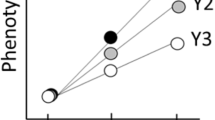Abstract
‘Haldane's rule’, formulated by J. B. S. Haldane in 1922, states that: “When in the F1 offspring of two different animal races one sex is absent, rare, or sterile, that sex is the heterozygous [heterogametic] sex” (ref. 1). His rule is now known to apply in mammals, lepidopterans, birds, orthopterans and dipterans1–5. In Drosophila, for example, Bock6 cites 142 cases of interspecific hybridizations that produce one sterile and one fertile sex in the offspring, all but one of these crosses yielding sterile XY males and fertile XX females. Despite much speculation, however, the genetic basis of Haldane's rule remains unknown. Haldane himself rejected the simple explanation that males are innately more sensitive than females to the effects of hybridization because groups with heterogametic females (such as birds and butterflies) usually show female sterility in hybrids, so that heterogamety itself is the critical feature. He and others1,2,4,7 suggested that heterogametic infertility or inviability in hybrids arises by a genetic imbalance between X chromosomes and autosomes. An alternative explanation5,8,9 is that this syndrome is caused by a mismatch of X and Y chromosomes. Here I show that in the Drosophila melanogaster subgroup, Haldane's rule for fertility apparently arises from a genetic interaction between X and Y chromosomes and not from an imbalance between sex chromosomes and autosomes. This finding has important implications for understanding the evolution of interspecific reproductive isolation.
This is a preview of subscription content, access via your institution
Access options
Subscribe to this journal
Receive 51 print issues and online access
$199.00 per year
only $3.90 per issue
Buy this article
- Purchase on Springer Link
- Instant access to full article PDF
Prices may be subject to local taxes which are calculated during checkout
Similar content being viewed by others
References
Haldane, J. B. S. J. Genet. 12, 101–109 (1922).
White, M. J. D. Animal Cytology and Evolution (Cambridge University Press, 1973).
White, M. J. D., Contreros, M., Cheney, J. & Webb, G. C. Chromosoma 61, 127–148 (1977).
Harvey, A. W. Biol. J. Linn. Soc. 12, 349–355 (1979).
Curtis, C. F., Langley, P. A. & Trewern, M. A. Heredity 45, 405–410 (1980).
Bock, I. R. Evol. Biol. 18 (in the press).
Bacci, G. Sex Determination (Pergamon, Oxford, 1965).
Haldane, J. B. S. The Causes of Evolution (Longmans, Green, New York, 1932).
Fraccaro, M., Trepolo, L., Laudani, V., Marchi, A. & Jayakar, S. D. Nature 265, 327–328 (1977).
Dobzhansky, T., Ayala, F. J., Stebbins, G. L. & Valentine, J. W. Evolution (Freeman, San Francisco, 1977).
Dobzhansky, T. J. Genet. 34, 135–151 (1937).
David, J., Lemeunier, F., Tsacas, L. & Bocquet, C. Ann. Genet. 17, 235–241 (1974).
Tsacas, L. & David, J. Bull. Soc. Ent. Fr. 79, 42–46 (1974).
Tsacas, L. & Bächli, G. Revue fr. Ent. (nouv. Ser.) 3, 146–150 (1981).
Lemeunier, F. & Ashburner, M. Chromosoma 89, 343–351 (1984).
Williamson, J. H. in The Genetics and Biology of Drosophila, Vol. 1b (eds Ashburner, M. & Novitski, E.) 667–699 (Academic, London, 1976).
Livak, K. J. Genetics 107, 611–634 (1984).
Coyne, J. A. Proc. natn. Acad. Sci. U.S.A. 81, 4444–4447 (1984).
Bridges, C. B. Genetics 1, 1–52 (1916).
Hardy, R. W. et al. Genetics 107, 591–610 (1984).
Sanchez, L. Experientia 38, 448–449 (1984).
Author information
Authors and Affiliations
Rights and permissions
About this article
Cite this article
Coyne, J. The genetic basis of Haldane's rule. Nature 314, 736–738 (1985). https://doi.org/10.1038/314736a0
Received:
Accepted:
Issue Date:
DOI: https://doi.org/10.1038/314736a0
This article is cited by
-
100 Years of Haldane’s Rule
Resonance (2023)
-
Genetic basis to hybrid inviability is more complex than hybrid male sterility in Caenorhabditis nematodes
Heredity (2018)
-
Genetic mapping of a male factor subfertility locus on mouse chromosome 4
Mammalian Genome (2018)
-
Using the inbred mouse strain SPRET/EiJ to provide novel insights in inflammation and infection research
Mammalian Genome (2018)
-
A rare exception to Haldane’s rule: Are X chromosomes key to hybrid incompatibilities?
Heredity (2017)
Comments
By submitting a comment you agree to abide by our Terms and Community Guidelines. If you find something abusive or that does not comply with our terms or guidelines please flag it as inappropriate.



